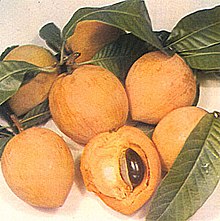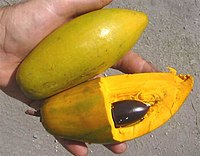Pouteria campechiana
From Wikipedia, the free encyclopedia
(Redirected from Canistel)
| Canistel | |
|---|---|
 | |
| Scientific classification | |
| Kingdom: | Plantae |
| (unranked): | Angiosperms |
| (unranked): | Eudicots |
| (unranked): | Asterids |
| Order: | Ericales |
| Family: | Sapotaceae |
| Genus: | Pouteria |
| Species: | P. campechiana |
| Binomial name | |
| Pouteria campechiana Baehni | |
| Synonyms | |
Knuth | |
The canistel (Pouteria campechiana) is an evergreen tree native to southern Mexico and Central America.[1] It is cultivated in other countries, such as Brazil, Taiwan, and Vietnam for its fruit.
The canistel grows up to 10 meters (33 ft) high, and produces orange-yellow fruit, also called yellow sapote, up to 7 centimeters (2.8 in) long, which are edible raw. Canistel flesh is sweet, with a texture often compared to that of a cooked egg yolk, hence its colloquial name of "eggfruit." It is closely related to the Mamey sapote and abiu.
Contents[hide] |
Uses[edit]
The canistel displays climacteric fruit ripening. A fully mature fruit shows an intense yellow skin colour. It will eventually soften and drop from the tree. Surprisingly, the fruit flesh remains untouched by insects or birds, perhaps because of astringent principles, that are much reduced in senescent fruits, but still perceptible to the human palate. Apparently mature fruits severed from the tree while still hard often fail to develop the desired climacteric changes in terms of reduced astringency and a texture reminiscent of egg yolk. This and the fact that climacteric fruits quickly start to decay at ambient temperatures may have contributed to the low economic importance of the canistel, a fruit species that many regard as delicious, and easy to process.
As the related lucuma the canistel can be eaten out of hand. The fruit flesh blended with milk yields an attractive creamy shake or a more viscous, custard-like, mildly sweet and aromatic dessert.
Etymology[edit]
Its binomial name is derived from the Mexican town of Campeche, where it is native. It is sometimes (wrongly) referred to as Lucuma campechiana. In the Philippines it is called chesa. In Sri Lanka this fruit is known as Laulu, Lavulu or Lawalu.[2] In Thailand it is known by different traditional popular names such as Lamut Khamen (ละมุดเขมร="Khmer Sapodilla") or Tho Khamen (ท้อเขมร="Khmer Peach"), attributing a hypothetic Cambodian origin to this fruit.[3] Currently those names are officially discouraged and the name Mon Khai (ม่อนไข่), Khai meaning "egg", is favored.[4]
The plant's name in the Vietnamese language is cây trứng gà (“chicken egg” plant) because of the fruit's appearance. It also has the Vietnamese namelekima. This is very unusual because Vietnamese is a tonal, isolating language whose morphemes all consist of a single syllable. It appears that this name derives from the word lucuma.

No comments:
Post a Comment